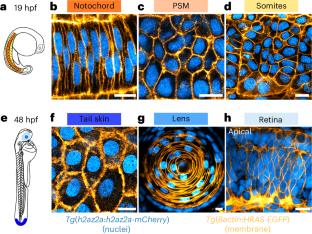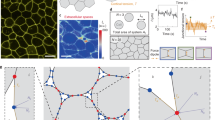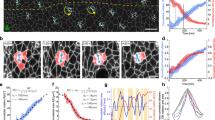Abstract
Jamming of cell collectives and associated rigidity transitions have been shown to play a key role in tissue dynamics, structure and morphogenesis. Cellular jamming is controlled by cellular density and the mechanics of cell–cell contacts. However, the contribution of subcellular organelles to the physical state of the emergent tissue is unclear. Here we report a nuclear jamming transition in zebrafish retina and brain tissues, where physical interactions between highly packed nuclei restrict cellular movements and control tissue mechanics and architecture. Computational modelling suggests that the nuclear volume fraction and anisotropy of cells control the emerging tissue physical state. Analysis of tissue architecture, mechanics and nuclear movements during eye development show that retina tissues undergo a nuclear jamming transition as they form, with increasing nuclear packing leading to more ordered cellular arrangements, reminiscent of the crystalline cellular packings in the functional adult eye. Our results reveal an important role of the cell nucleus in tissue mechanics and architecture.





Similar content being viewed by others
Data availability
The data supporting the findings of this study are included in the Article and its Supplementary Information files and are also available from the corresponding author upon request. Source data are provided with this paper.
Code availability
The simulation codes used in this Article are publicly available via GitHub at https://github.com/campaslab/active_foam_nucleus.
References
Heisenberg, C. P. & Bellaïche, Y. Forces in tissue morphogenesis and patterning. Cell 153, 948–962 (2013).
Guillot, C. & Lecuit, T. Mechanics of epithelial tissue homeostasis and morphogenesis. Science 340, 1185–1189 (2013).
Cohen, R. et al. Mechanical forces drive ordered patterning of hair cells in the mammalian inner ear. Nat. Commun. 11, 5137 (2020).
Salbreux, G., Barthel, L. K., Raymond, P. A. & Lubensky, D. K. Coupling mechanical deformations and planar cell polarity to create regular patterns in the zebrafish retina. PLoS Comput. Biol. 8, e1002618 (2012).
Kim, S., Cassidy, J. J., Yang, B., Carthew, R. W. & Hilgenfeldt, S. Hexagonal patterning of the insect compound eye: facet area variation, defects, and disorder. Biophys. J. 111, 2735–2746 (2016).
Mongera, A. et al. A fluid-to-solid jamming transition underlies vertebrate body axis elongation. Nature 561, 401–405 (2018).
Kim, S., Pochitaloff, M., Stooke-Vaughan, G. A. & Campàs, O. Embryonic tissues as active foams. Nat. Phys. 17, 859–866 (2021).
Petridou, N. I., Grigolon, S., Salbreux, G., Hannezo, E. & Heisenberg, C.-P. Fluidization-mediated tissue spreading by mitotic cell rounding and non-canonical Wnt signalling. Nat. Cell Biol. 21, 169–178 (2019).
Lenne, P. F. & Trivedi, V. Sculpting tissues by phase transitions. Nat. Commun. 13, 664 (2022).
Atia, L. et al. Geometric constraints during epithelial jamming. Nat. Phys. 14, 613–620 (2018).
Parada, C. et al. Mechanical feedback defines organizing centers to drive digit emergence. Dev. Cell 57, 854–866.e6 (2022).
Shelton, E. R. et al. Stress-driven tissue fluidization physically segments vertebrate somites. Preprint at BioRxiv https://doi.org/10.1101/2021.03.27.437325 (2021).
Lawton, A. K. et al. Regulated tissue fluidity steers zebrafish body elongation. Development 140, 573–582 (2013).
Bénaźeraf, B. et al. A random cell motility gradient downstream of FGF controls elongation of an amniote embryo. Nature 466, 248–252 (2010).
Schotz, E. M., Lanio, M., Talbot, J. A. & Manning, M. L. Glassy dynamics in three-dimensional embryonic tissues. J. R. Soc. Interface 10, 20130726–20130726 (2013).
Yanagida, A. et al. Cell surface fluctuations regulate early embryonic lineage sorting. Cell 185, 777–793.e20 (2022).
Oswald, L., Grosser, S., Smith, D. M. & Käs, J. A. Jamming transitions in cancer. J. Phys. D: Appl. Phys. 50, 483001–483018 (2017).
Palamidessi, A. et al. Unjamming overcomes kinetic and proliferation arrest in terminally differentiated cells and promotes collective motility of carcinoma. Nat. Mater. 80, 1252–1263 (2019).
Kang, W. et al. A novel jamming phase diagram links tumor invasion to non-equilibrium phase separation. iScience 24, 103252 (2021).
Campàs, O., Noordstra, I. & Yap, A. S. Adherens junctions as molecular regulators of emergent tissue mechanics. Nat. Rev. Mol. Cell Biol. 252–269 (2023).
Bonn, D., Denn, M. M., Berthier, L., Divoux, T. & Manneville, S. Yield stress materials in soft condensed matter. Rev. Mod. Phys. 89, 15 (2017).
Angelini, T. E. et al. Glass-like dynamics of collective cell migration. Proc. Natl Acad. Sci. USA 108, 4714–4719 (2011).
Park, J.-A. et al. Unjamming and cell shape in the asthmatic airway epithelium. Nat. Mater. 14, 1040–1048 (2015).
Krajnc, M. Solid–fluid transition and cell sorting in epithelia with junctional tension fluctuations. Soft Matter 16, 3209–3215 (2020).
Krajnc, M., Dasgupta, S., Ziherl, P. & Prost, J. Fluidization of epithelial sheets by active cell rearrangements. Phys. Rev. E 98, 022409 (2018).
Boromand, A., Signoriello, A., Ye, F., O’Hern, C. S. & Shattuck, M. D. Jamming of deformable polygons. Phys. Rev. Lett. 121, 248003 (2018).
Bi, D., Lopez, J. H., Schwarz, J. M. & Manning, M. L. A density-independent rigidity transition in biological tissues. Nat. Phys. 11, 1074–1079 (2015).
Bi, D., Yang, X., Marchetti, M. C. & Manning, M. L. Motility-driven glass and jamming transitions in biological tissues. Phys. Rev. X 6, 021011 (2016).
Farhadifar, R., Röper, J.-C., Aigouy, B., Eaton, S. & Jülicher, F. The influence of cell mechanics, cell-cell interactions, and proliferation on epithelial packing. Curr. Biol. 17, 2095–2104 (2007).
Lammerding, J. Mechanics of the nucleus. Compr. Physiol. 1, 783–807 (2011).
Jevtić, P., Edens, L. J., Vuković, L. D. & Levy, D. L. Sizing and shaping the nucleus: mechanisms and significance. Curr. Opin. Cell Biol. 28, 16–27 (2014).
Chow, K.-H., Factor, R. E. & Ullman, K. S. The nuclear envelope environment and its cancer connections. Nat. Rev. Cancer 12, 196–209 (2012).
Dutta, S., Djabrayan, N. J.-V., Torquato, S., Shvartsman, S. Y. & Krajnc, M. Self-similar dynamics of nuclear packing in the early Drosophila embryo. Biophys. J. 117, 743–750 (2019).
Donoughe, S., Hoffmann, J., Nakamura, T., Rycroft, C. H. & Extavour, C. G. Nuclear speed and cycle length co-vary with local density during syncytial blastoderm formation in a cricket. Nat. Commun. 13, 3889 (2022).
Kaiser, F. et al. Mechanical model of nuclei ordering in Drosophila embryos reveals dilution of stochastic forces. Biophys. J. 114, 1730–1740 (2018).
Azizi, A. et al. Nuclear crowding and nonlinear diffusion during interkinetic nuclear migration in the zebrafish retina. eLife 9, e58635 (2020).
Hecht, S. et al. Mechanical constraints to cell-cycle progression in a pseudostratified epithelium. Curr. Biol. 32, 2076–2083.e2 (2022).
Fuhrmann, S. Chapter three—eye morphogenesis and patterning of the optic vesicle. Curr. Top. Dev. Biol. 93, 61–84 (2010).
Agathocleous, M. & Harris, W. A. From progenitors to differentiated cells in the vertebrate retina. Annu Rev. Cell Dev. Biol. 25, 45–69 (2009).
Dowling, J. E. The Retina: An Approachable Part of the Brain, Revised Edition (Harvard Univ. Press, 2012).
Galli-Resta, L. et al. The genesis of retinal architecture: an emerging role for mechanical interactions? Prog. Retin. Eye Res. 27, 260–283 (2008).
Amini, R. et al. Amoeboid-like migration ensures correct horizontal cell layer formation in the developing vertebrate retina. eLife 11, e76408 (2022).
Lammerding, J. et al. Lamins A and C but not lamin B1 regulate nuclear mechanics. J. Biol. Chem. 281, 25768–25780 (2006).
Serwane, F. et al. In vivo quantification of spatially varying mechanical properties in developing tissues. Nat. Methods 14, 181–186 (2017).
Mongera, A. et al. Mechanics of the cellular microenvironment as probed by cells in vivo during zebrafish presomitic mesoderm differentiation. Nat. Mater. 22, 135–143 (2023).
Maia-Gil, M. et al. Nuclear deformability facilitates apical nuclear migration in the developing zebrafish retina. Preprint at bioRxiv https://doi.org/10.1101/2024.04.04.588091 (2024).
Mueller, T. & Wullimann, M. Atlas of Early Zebrafish Brain Development: A Tool for Molecular Neurogenetics (Academic Press, 2016).
Suzuki, D. G., Pérez-Fernández, J., Wibble, T., Kardamakis, A. A. & Grillner, S. The role of the optic tectum for visually evoked orienting and evasive movements. Proc. Natl Acad. Sci. USA 116, 15272–15281 (2019).
Lomakin, A. J. et al. The nucleus acts as a ruler tailoring cell responses to spatial constraints. Science 370, eaba2894 (2020).
Venturini, V. et al. The nucleus measures shape changes for cellular proprioception to control dynamic cell behavior. Science 370, eaba2644 (2020).
Nüsslein-Volhard, C. & Dahm, R. Zebrafish (Oxford Univ. Press, 2002).
Cooper, M. S. et al. Visualizing morphogenesis in transgenic zebrafish embryos using BODIPY TR methyl ester dye as a vital counterstain for GFP. Dev. Dyn. 232, 359–368 (2005).
Xiong, F. et al. Specified neural progenitors sort to form sharp domains after noisy Shh signaling. Cell 153, 550–561 (2013).
Knopf, F. et al. Bone regenerates via dedifferentiation of osteoblasts in the zebrafish fin. Dev. Cell 20, 713–724 (2011).
Pauls, S., Geldmacher-Voss, B. & Campos-Ortega, J. A. A zebrafish histone variant H2A.F/Z and a transgenic H2A.F/Z:GFP fusion protein for in vivo studies of embryonic development. Dev. Genes Evol. 211, 603–610 (2001).
Icha, J. et al. Using light sheet fluorescence microscopy to image zebrafish eye development. J. Vis. Exp. 110, e53966 (2016).
Tinevez, J.-Y. et al. TrackMate: an open and extensible platform for single-particle tracking. Methods 115, 80–90 (2017).
Lim, I. et al. Fluorous soluble cyanine dyes for visualizing perfluorocarbons in living systems. J. Am. Chem. Soc. 142, 16072–16081 (2020).
Acknowledgements
We thank I. Lim, H. Lin and E. Sletten (University of California, Los Angeles) for sharing custom-made fluorinated dyes. We also thank C. Froeb for technical support, G. Stooke-Vaughan for her help and also for bringing the study of the retina to the Campas lab, M. Valet for her scientific advice and support and all the other Campas lab members for their help. We thank the Fish Facility of the Max Planck Institute of Molecular Cell Biology and Genetics (MPI-CBG) for their technical support, the MPI-CBG imaging facility (especially J. Peychl) for their advice and technical support on image acquisition and the MPI-CBG Transgenic core facility (J. Braumann and R. Naumann) for bevelling and spiking glass needles. This work was supported by the Eunice Kennedy Shriver National Institute of Child Health and Human Development of the National Institutes of Health (R01HD095797 to O.C.), and the Deutsche Forschungsgemeinschaft (DFG, German Research Foundation) under Germany’s Excellence Strategy–EXC 2068–390729961–Cluster of Excellence Physics of Life of TU Dresden. We acknowledge support from the UCSB Center for Scientific Computing from the CNSI, MRL: NSF MRSEC (DMR-1720256) and NSF CNS-1725797.
Author information
Authors and Affiliations
Contributions
S.K., R.A. and O.C. designed the research. S.K. performed all the simulations. R.A. performed all the structural experiments and measurements of nuclear movements. R.A., S.-T.Y. and P.P. performed the mechanical measurements. A.B. and R.A. performed the laser ablation experiments. S.K., R.A., P.P., A.B. and I.A.D. analysed the data. S.K., R.A. and O.C. wrote the paper, with input from S.-T.Y., P.P. and A.B. O.C. supervised the project.
Corresponding author
Ethics declarations
Competing interests
The authors declare no competing interests.
Peer review
Peer review information
Nature Materials thanks Matthieu Piel and the other, anonymous, reviewer(s) for their contribution to the peer review of this work.
Additional information
Publisher’s note Springer Nature remains neutral with regard to jurisdictional claims in published maps and institutional affiliations.
Extended data
Extended Data Fig. 1 Effects of the magnitude of tension fluctuations on the nuclear jamming transition.
Dependence of long timescale MSRD values in terms of nuclear volume fraction for different magnitudes of tension fluctuations \(\Delta T/{T}_{0}\), showing that the dynamic slowdown in cell movements starts to occur at the same nuclear volume fraction (violet band) regardless of tension fluctuation strength. Error bands indicate standard deviation over N = 10 simulations.
Extended Data Fig. 2 Effects of nuclear stiffness on the nuclear jamming transition.
Dependence of the long timescale MSRD values (top) and neighbor exchange rate (bottom) for large nuclear volume fraction (\({\phi }_{N}=0.85\)) on the ratio of nuclear stiffness \({E}_{N}\) and the characteristic stress scale of cell deformations \({T}_{0}/{L}_{0}\). Large (small) values of \({E}_{N}/({T}_{0}/{L}_{0})\) indicate hard (soft) nuclei compared to the cell. Red lines are the values of long time MSRD and neighbor exchange rate for zero nuclear volume fraction (\({\phi }_{N}=0\)), and the vertical cyan dashed line indicates the point at which nuclear stiffness and the stress scale of cell deformations are equal, namely \({E}_{N}={T}_{0}/{L}_{0}\). Error bands indicate standard deviation over N = 10 simulations.
Extended Data Fig. 3 Schematic representation of the zebrafish retina before and after cell detachment from apical and basal tissue boundaries.
a, The zebrafish is a single-layered neuroepithelium with elongated cells connected to both the apical and basal tissue surfaces at 24 hpf. b, At approximately 40–42 hpf, majority of retinal cells detach from the tissue (apical and basal) boundaries and form a tissue with compact cells. This single-layered tissue eventually evolves into the different layers described in the main text (Fig. 3).
Extended Data Fig. 4 Tissue architecture during retina development: evolution of cell and nuclear shapes and sizes.
a-h, Top: schematic representation of cellular and nuclear architecture during different retinal stages (a, 24; b, 36; c, 55; e, 72; f, 92; g, 120 hpf). Bottom: Representative confocal sections of zebrafish retinae expressing the membrane marker (Tg(Bactin:HRAS-EGFP); orange) and nuclei marker Tg(h2az2a:h2az2a-mCherry); cyan). Scale bars, 20 μm. d, h, Higher magnification inset of the outlined region in (c), and (g) respectively. Scale bars, 10 μm.
Extended Data Fig. 5 Different brain regions show nuclear jamming.
Areas (a) and aspect ratios (b) of cells (orange) and nuclei (blue) in the MB (18 hpf) and OT (92 hpf). Their relative change between 18 to 92 hpf is plotted on the right panels. c, Nuclear volume fraction in the MB (18 hpf) and in the OT (92 hpf). Horizontal violet band shows the nuclear jamming volume fraction predicted theoretically (Fig. 2). d, Shape factor of cells (orange) and nuclei (blue) in the MB (18 hpf) and OT (92 hpf). Their relative change between 18 to 92 hpf is plotted on the right panels. MB (N = 6, n = 312), OT (N = 6, n = 419).
Supplementary information
Supplementary Information
Supplementary Notes 1–4.
Supplementary Video 1
Simulations of system dynamics for isotropic nuclei with varying nuclear volume fractions (φN = 0.20, 0.50 and 0.85 (from left to right)). Trajectories of 16 cells are shown in different colours.
Supplementary Video 2
Simulations of system dynamics for varying nuclear aspect ratios at large volume fractions (αN = 1, 2, 3 and 4 (from left to right); φN = 0.85). Trajectories of 16 cells are shown in different colours.
Supplementary Video 3
Representative video from a 4D time lapse of a 24 hpf retina of Tg(h2afz:GFP) embryo (nuclei, grey), overlaid with trajectories of 90 tracked nuclei. Time in h:min. Scale bar, 10 μm.
Supplementary Video 4
Representative video from a 4D time lapse of a 92 hpf retina of Tg(h2afz:GFP) embryo (nuclei, grey), overlaid with the trajectories of 90 tracked nuclei. Time in h:min. Scale bar, 10 μm.
Source data
Source Data Fig. 2
Source data for Fig. 2.
Source Data Fig. 3
Source data for Fig. 3.
Source Data Fig. 4
Source data for Fig. 4.
Source Data Fig. 5
Source data for Fig. 5.
Source Data Extended Data Fig. 1
Source data for Extended Data Fig. 1.
Source Data Extended Data Fig. 2
Source data for Extended Data Fig. 2.
Source Data Extended Data Fig. 3
Source data for Extended Data Fig. 3.
Source Data Extended Data Fig. 6
Source data for Extended Data Fig. 6.
Rights and permissions
Springer Nature or its licensor (e.g. a society or other partner) holds exclusive rights to this article under a publishing agreement with the author(s) or other rightsholder(s); author self-archiving of the accepted manuscript version of this article is solely governed by the terms of such publishing agreement and applicable law.
About this article
Cite this article
Kim, S., Amini, R., Yen, ST. et al. A nuclear jamming transition in vertebrate organogenesis. Nat. Mater. (2024). https://doi.org/10.1038/s41563-024-01972-3
Received:
Accepted:
Published:
DOI: https://doi.org/10.1038/s41563-024-01972-3
- Springer Nature Limited





